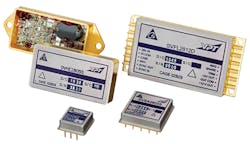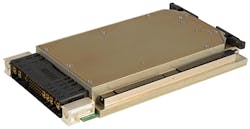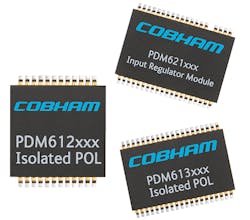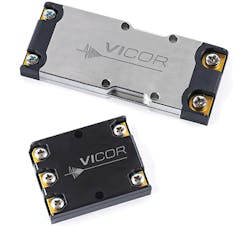New designs and open-systems architectures are enabling power device manufacturers to provide small, lightweight, and power-efficient devices for a wide variety of land, aircraft, and space applications.
By John Keller
Power electronics technology that controls and conditions electric power for complex aerospace and defense integrated systems is relying on new architectural approaches to achieve ever-smaller size, weight, power consumption, and cost (SWaP-C).
Enhanced power efficiency, thermal management, and resistance to the effects of electromagnetic interference (EMI) in power electronics devices like AC-DC and DC-DC converters is helping spawn new military electronics systems that are smaller, more lightweight, more tightly integrated, and easier to cool than ever before.
VPT Inc. is looking to commercial off-the-shelf (COTS) power technologies to give customers plenty of power performance at a reasonable cost.
These small-size, power-efficient devices hold promise for new aerospace and defense electronics applications in unmanned vehicles, surveillance radar, electronic warfare (EW), missiles and missile defense, infrared sensors, wearable electronics, and perhaps even space-based energy harvesting.
One way power electronics designers are achieving their SWaP goals is by improving efficiency. Engineers at Vicor Corp. in Andover, Mass., are moving beyond traditional power bricks to a different approach in the company’s DCM products, which is enabling them to design devices that are two to three times smaller than the company’s previous-generation power bricks.
Power efficiency
“Efficiency is key,” says Kai Johnstad, senior product marketing manager at Vicor. “The more useful power you are converting, the less waste heat you are generating. A lot more of the power is being converted, but it is easier to cool.” Vicor DCM products are not really bricks, but are power components that are in a much smaller package, he says.
“That also means that if we are providing more delivered power, designers can add more features to their products, or add more functions because they have power available,” says John Sturm, vice president of sales in the Americas for Vicor.
Milpower Source is producing power electronics packaged in the VPX form factor to enhance design flexibility and help bring down costs.
“What Vicor does differently is our switching topology,” Sturm says. “We can switch our converters at a much higher frequency, and it enables us to reduce the size of our magnetic components. That translates into much smaller size and weight than our competitors.”
This is different from the company’s older power brick designs. “Originally with our brick products, we took advantage of a frequency modulation technique using a switching element — a MOSFET [metal oxide silicon field-effect transistor] — that chops current. Still, switching is something that can cause noise and loss, and we focused on zero voltage and current switching to ensure there is zero current going through the device. The switch only turns on or off at zero current to produce nearly a lossless switch.”
Cobham Semiconductor Solutions in Colorado Springs, Colo., specializes in power products for manned space and satellite applications — an environment where power efficiency is a crucial consideration.
“Wide-bandgap technology is a fundamental enabler to achieving that,” explains Tim Meade, staff applications engineer at Cobham Semiconductor. “Size, weight, power, and cost: all those attributes are critical for satellites and this small-sats revolution. To get there we need to be increasing power density, increasing efficiency, getting smart power, and energy harvesting.”
Energy harvesting
Energy harvesting refers to extracting electrical energy from the environment. Solar arrays and photovoltaics are examples. On Earth, harvesting power from wind power and the kinetic motion of moving waves are obvious applications for energy harvesting, but in space the challenge is more tricky.
Wide-bandgap devices like GaN have smaller gate capacitance and lower gate charge than silicon, Meade explains. The benefit is you can achieve better power density because you can switch the device more quickly and keep it regulated at the target voltage.
“In space, even more exciting, is the prospect of extracting the energy from antennas through RF, and from electromagnetic fields like the Earth’s polar spheres. These have the potential for energy harvesting,” Meade says. “The challenge is how much you can extract from that environment.”
Crucial to achieving the kinds of power efficiencies necessary for new generations of space-based energy harvesting are wide-bandgap technologies like gallium nitride (GaN) and silicon carbide (SiC) semiconductor technologies. Although GaN and SiC technologies still are relatively new, “I do see a lot of interest in the space community to get away from standard silicon and take advantage of these wide-bandgap devices,” Meade says.
Wide-bandgap technologies have to do with voltage, Meade explains. “Wide-bandgap devices have three electron volts, and it has to do with how well-defined the transition is from conduction to non-conduction.”
Wide-bandgap technologies are not the only key to enhancing power electronics efficiencies in space. “A satellite is in-itself its own power ecosystem; it generates its own power, conditions it, converts, and distributes it,” Meade explains. “It’s a wide-open environment for growth and advancement.”
Electromagnetic interference
Part of how efficiently a power electronics device operates involves the amount of electromagnetic interference (EMI) it generates. This is particularly crucial as the number of electronic subsystems aboard spacecraft, military planes, ships, and land vehicles increases, which poses the threat of cross-system EMI.
“More power, more systems on aircraft and ground vehicles, and those systems interfering with one another is a big concern,” says Brian Paul, business development manager at Milpower Source Inc. in Belmont, N.H. “EMI has become a major driver for us.”
Milpower Source engineers have integrated an EMI filter onto power electronics modules not only to help reduce size and weight, but also to offer open-architecture power devices to save costs and promote component interoperability. “We are one of the few suppliers that can integrate the EMI filter on to the card, so we can produce a product with more capability in a smaller package,” Paul says.
Cobham is targeting high efficiencies in power electronics for size- and weight-sensitive space applications.
Milpower Source offers power modules in the standard 3U and 6U VPX form factor. “MILVPX is our trade name, and as a product family it provides building blocks that our customers can built to, and that are tailorable,” Paul says. “This is very powerful within our industry. It’s designed from the ground-up for military applications.”
Paul says Milpower’s gains in efficiency are from the company’s power circuit designs. “We don’t design bricks; we design with our own power circuits,” he says. “We have a more powerful, efficient design.” This helps the company’s products not only increase in power, but also in their ability to cool waste heat.
“In the 3U form factor, we are seeing growing power levels,” Paul says. “We have more than a 600-watt capability in a 3U form factor. Moving toward conduction cooling — sending heat out through the rails — is a first step. We work with our customers on where they place the power supply, and fundamentally we look at heat early in the process. We have a new VPX product that will be conduction-cooled, for when you want to move heat more rapidly.”
Architectural designs
Part of Milpower’s success comes from the flexibility of the VPX open-systems architecture, Paul says. “It all comes down to the form factor; if VPX meets the customer’s form factor needs, then we can be flexible in the other aspects of the standard. The standard gives us some direction in the market.”
Using open standards like VPX also enables power electronics suppliers to help their customers control costs. “In the traditional mil/aero market, many programs are getting more pressure to control their costs,” says Leonard Leslie, vice president of engineering at VPT Inc. in Blacksburg, Va.
“It depends on the customer’s needs,” Leslie says. “Some will demand full-temperature-range hermetic designs because those are the program requirements. But where those requirements have been relieved for cost, then the COTS [commercial off-the-shelf] parts can be a good alternative the save the program money with similar performance — electrically and mechanically — but at a lower price point.”
VPT specializes in power electronics for space, aircraft, and military land vehicle applications. The company offers full mil-spec hermetic devices, as well as the VPT and VXR COTS power converters, which operate in temperatures from -55 to 100 degrees Celsius.
“The obvious difference is the COTS parts don’t cover the full temperature range, so you lose temperature on the top end,” Leslie says. “The VXR series are newer parts that have much wider operating capability with a wider input range for operation on aircraft databuses without surge protection.”
Among VPT’s primary target markets is so-called “new space,” which involves relatively inexpensive communications satellites with limited life spans.
Vicor Corp. is looking beyond the traditional power brick module to offer new designs that are two to three times smaller than previous-generation power products.
“It’s a healthy business already with traditional military and commercial space applications, and right now there is a huge interest in new space — all these ventures that are trying to put up large constellations of low-Earth-orbit satellites for Internet coverage.
“There is an interim period where these companies try to put up satellites that need to last five to seven years to be economically viable,” Leslie continues. “They can’t afford the full-rad-hard, space-qualified parts traditionally sold into a long-duration geosynchronous satellite or military satellite, but they are trying to fill a need.”
Can COTS parts fill the needs of these future medium-duration satellites? Perhaps, but the real answer isn’t clear yet.
“We are looking at our COTS parts for that need, but we don’t have an answer for it yet,” Leslie says. “It’s still up in the air with customers, but they are looking at compromises to make their builds viable from a cost perspective.”
COMPANY LIST
Absopulse Electronics Ltd.
Ottawa
https://absopulse.com
Advanced Energy Industries Inc.
Fort Collins, Colo.
www.advanced-energy.com
Aegis Power Systems Inc.
Murphy, N.C.
www.aegispower.com
AMETEK VTI Instruments
Irvine, Calif.
www.vtiinstruments.com
Analytic Systems Ware Ltd.
Delta, British Columbia
www.analyticsystems.com
Anaren Inc.
Syracuse, N.Y.
hwww.anaren.com
Astrodyne TDI
Nashua, N.H.
www.astrodynetdi.com
AVX Corp.
Concord, Calif.
www.calex.com
Behlman Electronics Inc.
Hauppague, N.Y.
www.behlmanpower.com
Calex Mfg. Co. Inc.
Cary, Ill.
www.coilcraft.com
Cobham Semiconductor Solutions
Concord, Calif.
www.contech-us.com
Coilcraft Inc.
Colorado Springs, Colo.
www.cobham.com
Comdel Inc.
Gloucester, Mass.
www.comdel.com
ConTech
Liberty, S.C
www.cde.com
Cornell Dubilier Electronics Inc.
Redmond, Wash.
www.craneae.com
Crane Aerospace & Electronics
Hiawatha, Iowa
www.crystalrugged.com
Crystal Group
Lawrence, Mass.
https://d6industries.com
D6 Industries Inc.
San Diego
www.ga.com/ems
Data Device Corp. (DDC)
Bohemia, N.Y.
www.ddc-web.com
Energy Technologies Inc.
Mansfield, Ohio
www.ruggedsystems.com
Falcon Electric Inc.
Irwindale, Calif.
www.falconups.com
Gaia Converter Inc.
Le Haillan, France
www.gaia-converter.com
General Atomics Electromagnetic Systems Group
Grand Rapids, Mich.
www.geaviation.com
GE Aviation Systems
Santa Rosa, Calif.
www.keysight.com
Infineon technologies (formerly International Rectifier)
El Segundo, Calif.
https://www.infineon.com
Interpoint, a Crane Co.
Redmond, Wash.
www.interpoint.com
Keysight Technologies Inc.
Chelmsford, Mass.
www.maximintegrated.com
Maxim Integrated Products Inc
Mansfield, Mass.
www.murata-ps.com
Murata Power Solutions
Hessen, Germany
https://eu.industrial.panasonic.com
North Atlantic Industries
Bohemia, N.Y.
www.naii.com
Panasonic Automotive & Industrial Systems Europe
Pelham, N.Y.
www.picoelectronics.com
Pico Electronics Inc.
Dover, Pa.
www.raycomelectronics.com
Rantec Power Systems Inc.
Los Osos, Calif.
www.rantec.com
Raycom Electronics Inc.
Milpitas, Calif.
www.intersil.com
Renesas Electronics Corp. (formerly Intersil)
San Diego
www.us.tdk-lambda.com
Solitron Devices, Inc.
West Palm Beach, Fla.
www.solitrondevices.com
SynQor
Boxborough, Mass.
www.synqor.com
TDI Power
Hackettstown, N.J.
http://tdipower.com/
TDK-Lambda Americas Inc.
Bothell, Wash.
www.vptpower.com
Vicor Corp.
Andover, Mass.
www.vicr.com
VPT Inc.
Bothell, Wash.
www.vptpower.com




